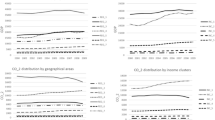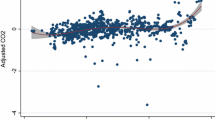Abstract
Although panel data have been used intensively by a wealth of studies investigating the GDP-pollution relationship, the poolability assumption used to model these data is almost never addressed. This paper applies a strategy to test the poolability assumption with methods robust to functional misspecification. Nonparametric poolability tests are performed to check the temporal and spatial homogeneity of the panel and their results are compared with the conventional F-tests for a balanced panel of 48 Spanish provinces on four air pollutant emissions (CH4, CO, CO2 and NMVOC) over the 1990–2002 period. We show that temporal homogeneity may allow the pooling of the data and drive to well-defined nonparametric and parametric cross-sectional U-inverted shapes for all air pollutants. However, the presence of spatial heterogeneity makes this shape compatible with different time-series patterns in every province—mainly increasing or decreasing depending on the pollutant. These results highlight the extreme sensitivity of the income-pollution relationship to region- or country-specific factors.
Similar content being viewed by others
References
Aldy JE (2005). An environmental Kuznets curve analysis of U.S. state-level carbon dioxide emissions. J Environ Dev 14: 48–72
Azomahou T, Laisney F and Van Nguyen P (2006). Economic development and CO2 emissions: a nonparametric panel approach. J Public Econ 90: 1347–1363
Baltagi BH, Hidalgo J and Li Q (1996). A nonparametric test for poolability using panel data. J Econom 75: 345–367
Bertinelli L and Strobl E (2005). The environmental Kuznets curve semi-parametrically revisited. Econ Lett 88: 350–357
Brock WA, Taylor MS (2004) Economic growth and the environment: a review of theory and empirics. Working paper 10854, NBER Oct. 2004
Copeland BR and Taylor MS (2003). Trade and the environment. Princeton University Press, New Jersey
van den Bergh JCJM, Opschoor JB and Bruyn JM (1998). Economic growth and emissions: reconsidering the empirical basis of environmental Kuznets curves. Ecol Econ 25: 161–175
Dijkgraaf E and Vollebergh RJ (2005). A test for parameter homogeneity in CO2 panel EKC estimations. Environ Resour Econ 32: 229–239
De Groot HLF, Withagen CA and Minliang Z (2004). Dynamics of China’s regional development and pollution: an investigation into the environmental Kuznets curve. Environ Dev Econ 9: 507–537
Grossman GM and Krueger AB (1995). Economic growth and the environment. Q J Econ 112: 353–378
Heil MT and Selden TM (2001). Carbon emissions and economic development: future trajectories based on historical experience. Environ Dev Econ 6: 63–83
Herrero C, Soler A, Villar A (2004) Capital Humano y Desarrollo Humano en España, sus Comunidades Autónomas y Provincias. 1980–2000. Programa de apoyo al capital humano, Fundación Bancaja y Instituto Valenciano de Investigaciones Económicas (Ivie)
Holtz-Eakin D and Selden TM (1995). Stocking the fires? CO2 emissions and economic growth. J Public Econ 57: 85–101
Hsiao C (2003). Analysis of panel data. Cambridge University Press, Cambridge
Koop G and Tole L (1999). Is there an the environmental Kuznets curve for deforestation. J Dev Econ 58: 231–244
List JA and Gallet CA (1999). The environmental Kuznets curve: does one size fit all?. Ecol Econ 31: 409–423
Millimet DL, List JA and Stengos T (2003). The environmental Kuznets curve: real progress or misspecified models?. Rev Econ Stat 85(1): 1038–1047
Perman R, Stern DI (2003) Evidence from panel unit root and cointegration tests that the environmental Kuznets curve does not exist. Aust J Agric Resour Econ 47(3)
Robinson P (1988). Root-N-consistent semiparametric regression. Econometrica 56: 931–954
Roca J, Padilla E, Farre M and Galletto V (2001). Economic growth and atmospheric pollution in Spain: discussing the environmental Kuznets curve hypothesis. Ecol Econ 39: 85–99
Schmalensee R, Stoker TM and Judson RA (1998). World carbon dioxide emissions: 1950–2050. Rev Econ Stat 80: 15–27
Selden TM and Song D (1994). Environmental quality and development: is there a Kuznets curve for air pollution emissions?. J Environ Econ Manage 27: 147–162
Stern DI (2003) The environmental Kuznets curve. Internet Encyclopaedia of Ecological Economics, June 2003
Taskin F and Zaim O (2000). Searching for a Kuznets curve in environmental efficiency using kernel estimation. Econ Lett 68: 217–223
van Nguyen P, Azomahou T (2007) Heterogeneity in environmental quality: an empirical analysis of deforestation. J Dev Econo 84(1)
Vollebergh HRJ, Dijkgraaf E, Melenberg B (2005) Environmental Kuznets curves for CO2: heterogeneity versus homogeneity. Discussion paper 25, CentER, Tilburg University 2005
Wood S (2006) Generalized additive models: an introduction with R, vol. 67. Chapman & Hall, Texts in Statistical Sciences
Yatchew A (2003). Semiparametric regression for the applied econometrician. Cambridge University Press, Cambridge
Author information
Authors and Affiliations
Corresponding author
Rights and permissions
About this article
Cite this article
Ordás Criado, C. Temporal and Spatial Homogeneity in Air Pollutants Panel EKC Estimations. Environ Resource Econ 40, 265–283 (2008). https://doi.org/10.1007/s10640-007-9152-1
Received:
Accepted:
Published:
Issue Date:
DOI: https://doi.org/10.1007/s10640-007-9152-1




